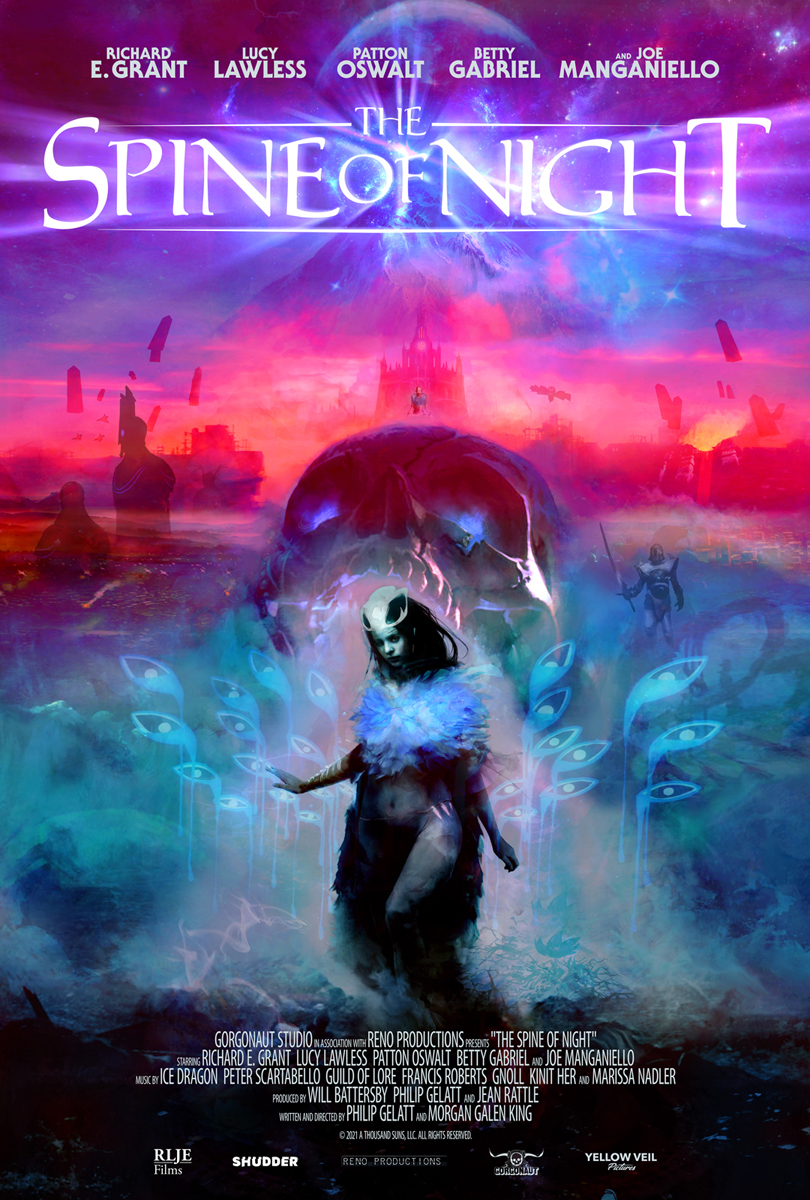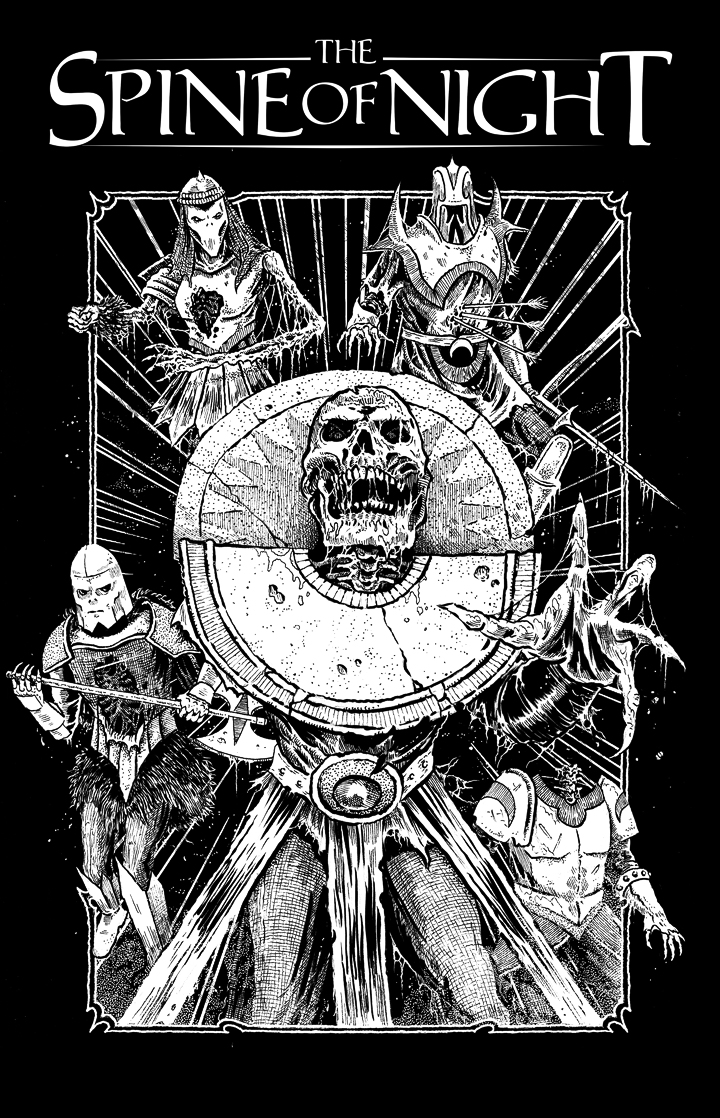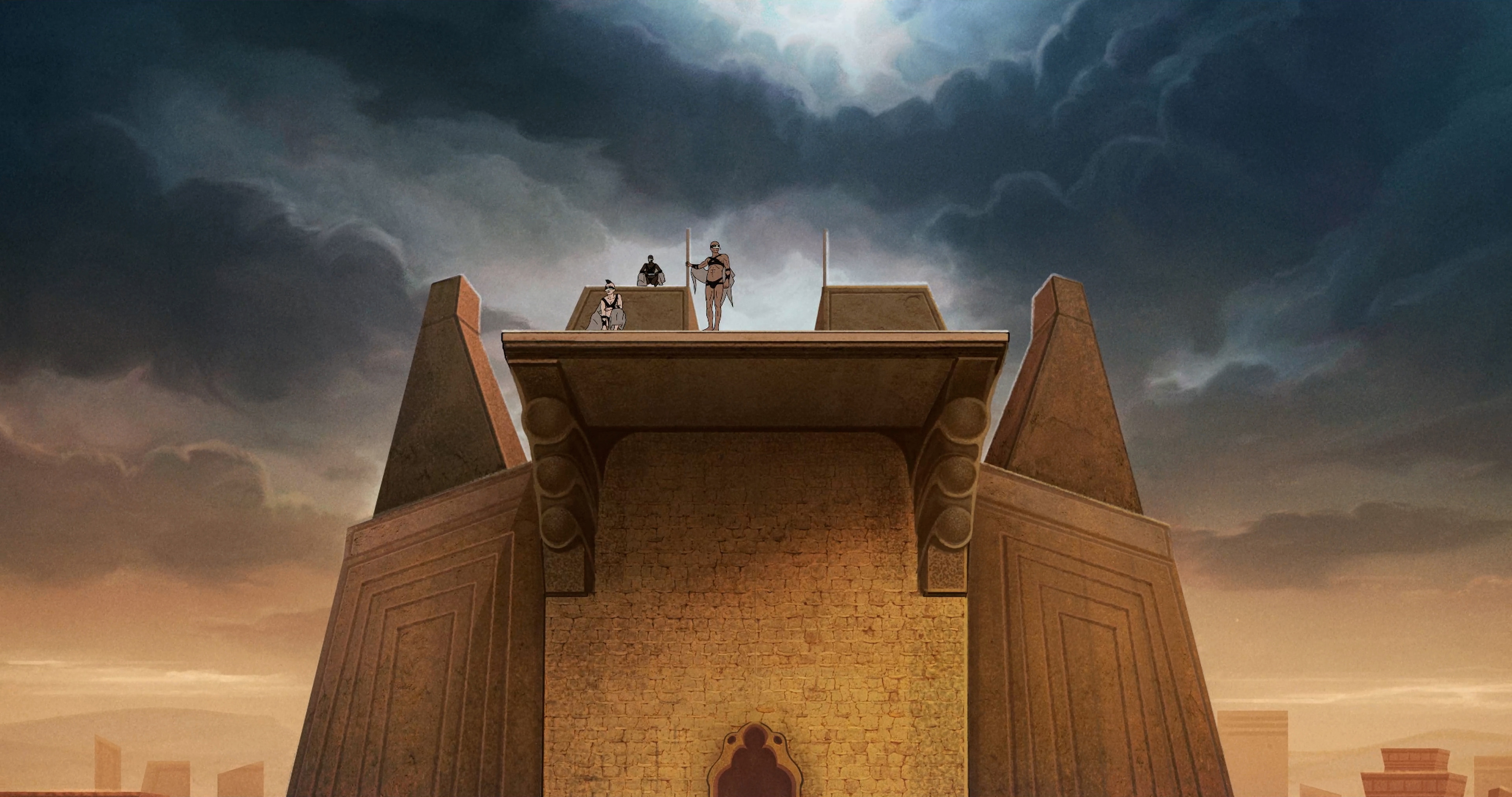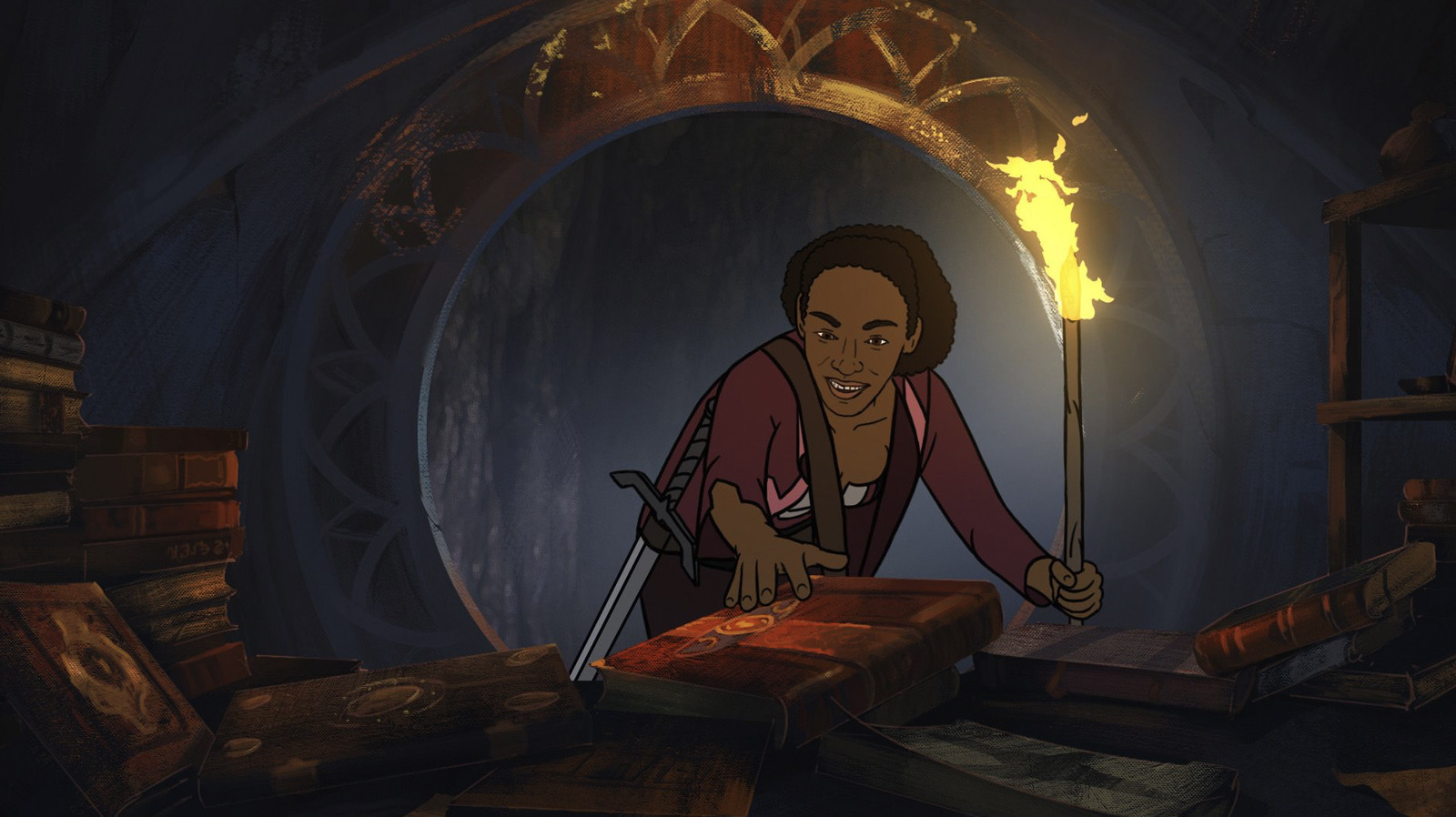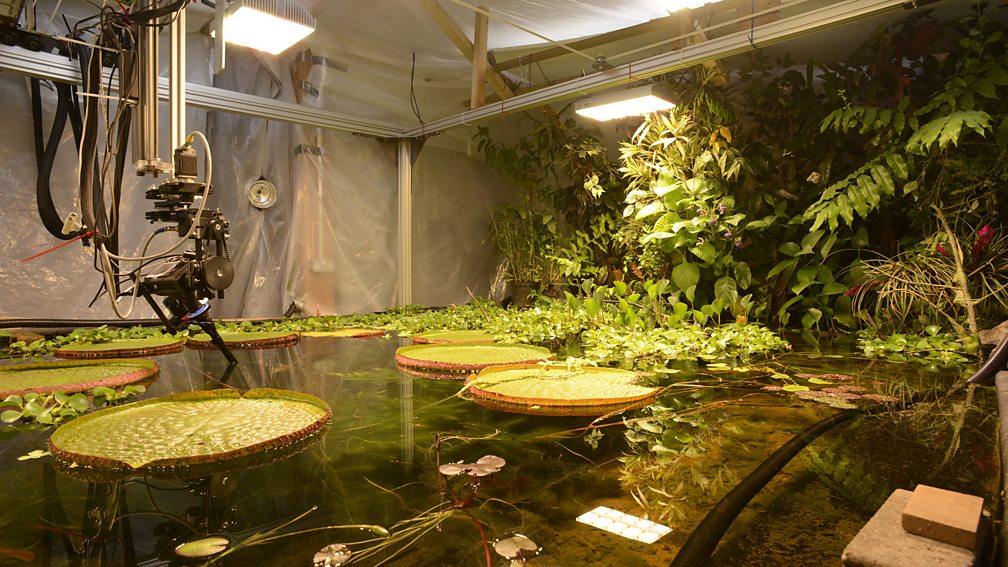timespace coordinates: an imaginary mythical time on a violent forlorn planet, not very unlike our own.
“The Spine of Night is a 2021 adult animated dark fantasy horror film written and directed by Philip Gelatt and Morgan Galen King.[1] It stars Richard E. Grant, Lucy Lawless, Patton Oswalt, Betty Gabriel, and Joe Manganiello.
The film was completed using rotoscoped animation, and traces the centuries long journey of a magical plant that bestows terrible power upon the user, as it inspires despots, empires, and black magic.” (wiki)
This has to be one of the highlights of animation in recent years – but not if one dreams for a more peaceful, pacifist or a non-violent (better) world. Ripping hearts out, dissolving meat off the bones, cutting people in half or dismemberment – a recurrent and very common characteristic of Spine of the Night. Lots of eerie blue phosphorescent flowers and lots of gaping skulls projected on starry skies. Heroic fantasy or sword & sorcery (especially the work of REH/R.E. Howard) was big bang moment for me and it was always pretty bloody and tactless. Altough, I must say it came with its own culturally specific ‘mirth’ – for these imaginary worlds were concocted by REH, and distributed by (Marvel) comics before the books came around (few of those in my collection too). Worlds I briefly inhabited got poached from smuggled comic books (Savage Sword of Conan, King Conan, Conan the Barbarian) arriving in ‘aid packages’ from my aunt in the US across the Iron Curtain to a kid in Ceaușescu’s Romania. Conan the Barbarian and King Kull of Valusia happen to overlap with my 1980s high school surroundings or my sporadic countryside haunts. Below the Carpathian mountains, around Prahova County, a wild distant hilly forested area, that I entered only much later was just behind the village of my childhood summer vacations. Let’s get this straight I wasn’t a country side kid, more of a city bookworm/documentary geek. Altough from that moment on the hills of Prahova became the realm of Cimmeria – the mythical land of Conan, a place based on a vague Black Sea region during the Greek antiquity.
“CIMMERIA (cca 1932)
by REH
I remember
The dark woods, masking slopes of sombre hills;
The grey clouds’ leaden everlasting arch;
The dusky streams that flowed without a sound,
And the lone winds that whispered down the passes.
Vista upon vista marching, hills on hills,
Slope beyond slope, each dark with sullen trees,
Our gaunt land lay. So when a man climbed up
A rugged peak and gazed, his shaded eye
Saw but the endless vista–hill on hill,
Slope beyond slope, each hooded like its brothers.
It was a gloomy land that seemed to hold
All winds and clouds and dreams that shun the sun,
With bare boughs rattling in the lonesome winds,
And the dark woodlands brooding over all,
Not even lightened by the rare dim sun
Which made squat shadows out of men; they called it
Cimmeria, land of Darkness and deep Night.
It was so long ago and far away
I have forgotten the very name men called me.
The axe and flint-tipped spear are like a dream,
And hunts and wars are like shadows. I recall
Only the stillness of that sombre land;
The clouds that piled forever on the hills,
The dimness of the everlasting woods.
Cimmeria, land of Darkness and the Night.
Oh, soul of mine, born out of shadowed hills, To clouds and winds and ghosts that shun the sun,
How many deaths shall serve to break at last
This heritage which wraps me in the grey Apparel of ghosts? I search my heart and find Cimmeria, land of Darkness and the Night”
The gravel on top of the gymnastics/sports hall next to my Bucharest school was strewn with small bones of dead animals. This made a perfect substrate for our Hyborian immersion. To that place where nobody could follow us, we arrived climbing up on a creaky rusty metal ladder – and in the distance we started seeing the rooftops shapes and church towers that would transform into temples of Mitra…
Conan, King Kull, Valeria, Thulsa Doom, Red Sonja (Brigitte Nielsen), Grace Jones playing Zula (all pulled from a growing comic book pantheon enlarged by Roy Thomas & Barry-Windsor Smith and others) ended up bringing havoc to an old and corrupt world, swept by sinister cults and pre-human civilisations with walled crumbling cities. These were all heroines and heroes that made civilized life into a sham, never adopting the mores for civilized men and women for long. All thieves, all brigands, tomb raiders, all hailing from the borderlands, the steppes and the forests, all former slaves, orphans or members of a barbarian hinterland that got raided as labor force pool or got sacrificed in the name of unknown gods or blood-thirsty cults. A pean to a neo- barbarian ethos born out of modern Fantasy that did not exist outside the invented Hyborian Age conjured up by that suicidal pulp fiction-writing Texan obsessed with physical culture called Robert E. Howard. There is much to be critical about it now – including a certain Social Darwinist bent – and a kind of might is right. At the same time there’s a sort of materialist common sense attitude of swords that make Gods or tyrants bleed, of sorcery or supernatural or Lovecraftian entities that are not invincible. So there’s always the risk of maybe too much sword and too little sorcery. On the scala of toxic masculinity many abcelebrated Frank Frazetta cover would score pretty high and come across as just reinforcing gender stereotypes, seemingly promoting those undultared, manly, virile, battle-scarred bodies forged in cosmic foundries – at the time of great changes of Fordism labor rights struggles and post-Fordist malaise. Those sweaty – sword wielding (working man) recently unemployed bodies that are so easy to ridicule in movies, as in the recent lumberjack character played with gusto by Nicholas Cage in Mandy. Work and virility was somehow on the go – labor was not only outsourced to a feminized Asia, but the whole regime of formerly unwaged labour, care work included more and more men – a feminization of work that started seeping into what had been once a working class industrial preserve.
Even with the heroic fantasy glorification of berserk battles, heavy metal/doom metal soundtrack & general mayhem, let’s also consider Conan the Barbarian mostly a kind of modern scavenger, a sort of Spartacus outsider that never accepted a warrior lifestyle and that was forced into it. From his initial peaceful village life Conan (in one account) was taken prisoner with other children, was pushed and had to adopt a slave – warrior livelihood, not because he was born into it. Conan used all his anger to mostly strike down civilized lords, power hungry priests and cruel rulers.

Now to this recent animation and how it departs from previous models even if stylistically has much in common with a whole genre of pulp. First in the Conan comics there’s is a certain class and even racial division amongst these pulp savages and barbarians. This is a recognizable colonial (Euro-American) separation of good barbarians vs bad barbarians – even in Conan THE Barbarian. There is the ‘noble savage’ and the rest, an Enlightment era division that has brought much misery and death to countless living native indigenous peoples. So in the comics there is “the Cimmerians” and there is “the Picts” of the Pictish Wilderland (usually a swamp or a jungle rainforest) as par of an extended REH universe. Classified as ‘primitive’, truly vicious they are almost like living examples of Darwinian evolutionary atavism. They are the remains of pulp racist pseudo science, representatives of the irrational primitive archetype, described in dehumanizing terms, as an animal-like – superstitious horde. I think The Spine of Night – even if at the surface tributary to REH universe does a benefic move towards foregrounding these reclusive swamp ‘savages’, their cause, the quest not of warriors or swordsmen but of witches, of pantheist and animist rituals. It also makes explicit the predatory relation of much of these civilisations & cities on this sparsely populated, un-cultivated, yet fertile hinterland. This I consider quite a big departure that puts to shame simplistic pulp comic divisions with a colonial inheritance. The Swamp is finally not a place of unnamed horrors like in Conan the Barbarian, but a place of various forms of life and where a very powerful plant thrives, a plant that is part of the ethno-botanical lore of these human groups. The horror is most likely to arrive with new intrusions, clearings, enclosures and with militaristic ecocidal ideology of brutal conquerors and their henchmen. I sense there’s a possible Bachofenian critique of patriarchy as a historical process, the arrival of a patriarchal order that took pride in treating both nature and women with the same brutality & rapacity. There’s also no passivity here – the swamp people don’t just dissappear and the witch is always coming back and ready to counter the worst of them.
Beside the knowledge vs power narrative there is something else in the Spine of Night – a way in which the great Swamp – is the first to disappear or to fall victim to the empires or to fires, and expansive drives for domination.
Another thing is the dependency of civilization, of the mighty on someone else, even on rare irretrievably lost knowledge, or on something that is non-human (or pre-human) or not recognized any longer as human. Rulers are always dependent on inhuman energies and entities. Or even better – in all their might they show a dependence and encourage the exploitation of a complex – nexus of other humans, their lore and practices and plants (magic flower) & biodiverse environments (swamp, wetlands, marshes). There is no development or spells or even warfare without these (one might recall here Londa S. studies of abortificient plants known to indigenous peoples as well as slaves) ‘political plants’ that are an integral lore of these swamp people in The Spine of Night.
It is the first epic time the actual heroine is a swamp witch, her quest is not the quest of the mercenary barbarian but of a revived cosmic witch queen that makes the last stand against a technologically- empowered, resource-hungry, and knowledge thirsty imperial power represented by a man, a former scholar. I am not going into details – and I think the images telling the mythical story of this bloody world are pretty telling because they include the killing of the gods in its cosmogony.
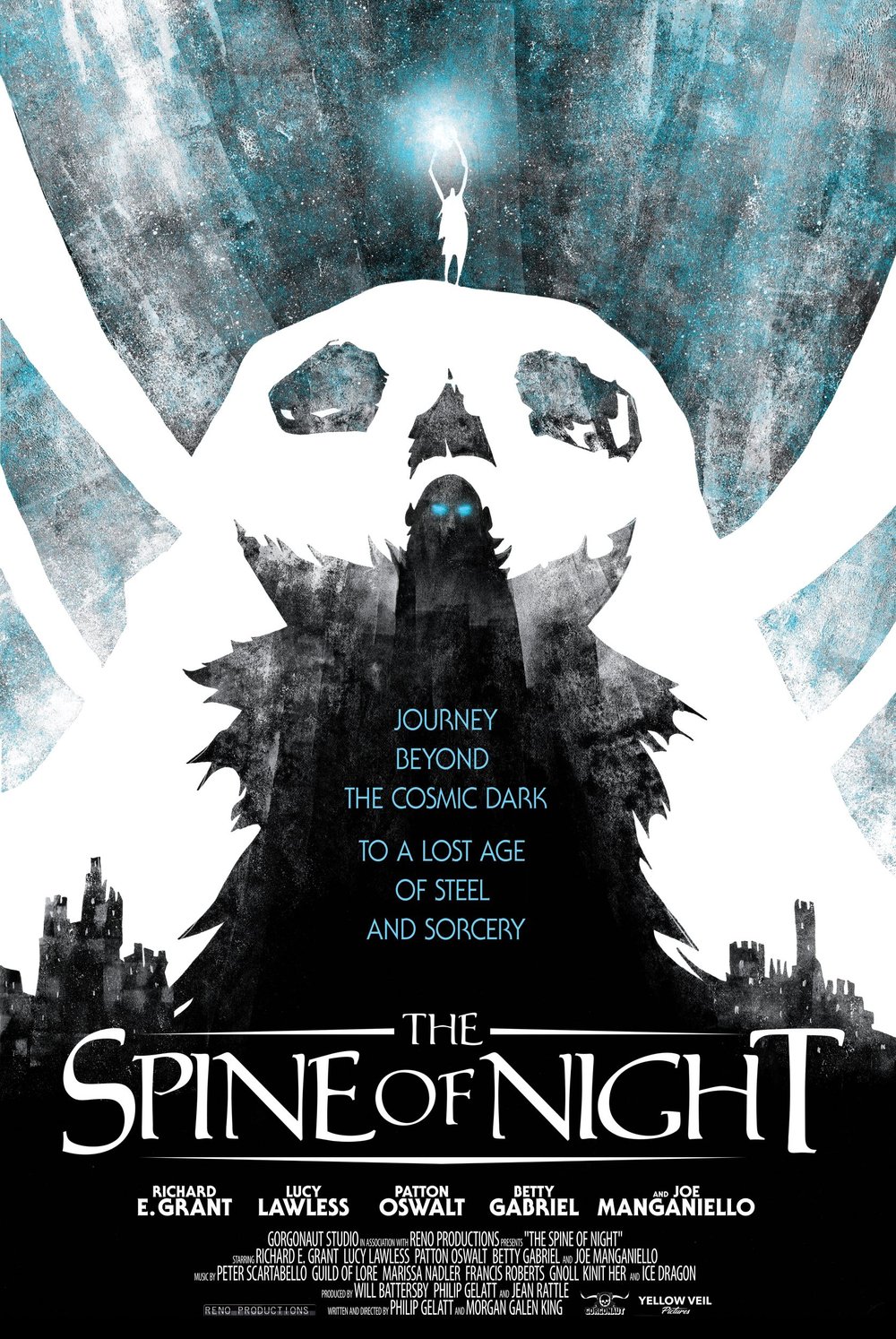
Knowledge or – ancient libraries and scholars are not all evil and corrupt, there is actually a few idealists left and a few dedicated to saving the plebs outside the gate. Yet it is clear that this kind of disdain combined with hoarding of knowledge in search of power brings only doom & destruction. There is also a knowledge that is non-literary, transmitted by oral cultures, what we might call oral/aural culture – so-called illiterate knowledge, one that does not get recorded so easily in the pages of grimoires. Besides the pungent mythical undertones in Spine of the Night – there is also the sense that a lot of specialized, ‘written’ knowledge is definitely growing in complete disregard for its human (humanistic) usage.
Apart of all these brief notes – the Spine of Night animation conveys the best cosmic dark epic doom entertainment since Ralph Bakshi’s collaboration with Frank Frazetta – on Ice and Fire, the 1983 dark epic fantasy rotoscoping masterpiece. Yet, I repeat I do not consider it a mere piece of geek nostalgia per se – but a powerful new and welcome turn of an old animation technique (to be enjoyed and practiced). Visually it is not so much – like a lot of recent animation – one technique, but a kaleidoscope of techniques and technologies both digital & analog, hand-drawn & CGI, combining ‘realist’ rotoscoping style with abstract – dark silhouettes with blazing eyes and patches of ‘bioluminescent’ parafernalia (like characters in the cosmogonic/Titanomachy scenes). Instead of just images of decay, or constant dissolution of forms – animation in Spine of Night is mostly about metamorphoses (like Levitt puts it in her Animatic Apparatus), morphing and melting the boundaries of usual anthropomorphic – figurative shapes. The background art is very effective and stands on its own even without the action – because all the environmental elements are unstable, lines tremble, the sky/cosmos constantly is prone to paraeidolia – skulls get distended & extended into galaxies. One could say in the Titanomachy – god killing scenes, what we see is a cosmogony of the animation process itself, the unseen acts (techniques, technologies, rotoscoping etc) enacting the ani-motion principle, “the artificing of man” (Cholodenko) – the dreams of silent creators, lively nightmarish creations that overtake and revert the roles, rob their creators special effects & take on a life of their own.
imdb
